
Mary Baker Eddy was an American religious leader and author who founded The Church of Christ, Scientist, in New England in 1879. She also founded The Christian Science Monitor in 1908, and three religious magazines: the Christian Science Sentinel, The Christian Science Journal, and The Herald of Christian Science. She wrote numerous books and articles, the notable of which were Science and Health with Key to the Scriptures and Manual of The Mother Church. Other works were edited posthumously into the Prose Works Other than Science and Health.

Beacon Hill is a historic neighborhood in Boston, Massachusetts, and the hill upon which the Massachusetts State House resides. The term "Beacon Hill" is used locally as a metonym to refer to the state government or the legislature itself, much like Washington, D.C.'s Capitol Hill does at the federal level.
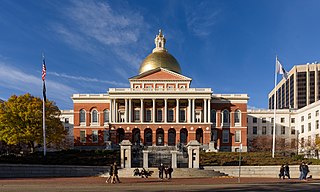
The Massachusetts State House, also known as the Massachusetts Statehouse or the New State House, is the state capitol and seat of government for the Commonwealth of Massachusetts, located in the Beacon Hill neighborhood of Boston. The building houses the Massachusetts General Court and the offices of the Governor of Massachusetts. The building, designed by architect Charles Bulfinch, was completed in January 1798 at a cost of $133,333, and has repeatedly been enlarged since. It is one of the oldest state capitols in current use. It is considered a masterpiece of Federal architecture and among Bulfinch's finest works, and was designated a National Historic Landmark for its architectural significance.

Chestnut Hill is a wealthy New England village located six miles (10 km) west of downtown Boston, Massachusetts, United States. It is best known for being home to Boston College and a section of the Boston Marathon route. Like all Massachusetts villages, Chestnut Hill is not an incorporated municipal entity. It is located partially in Brookline in Norfolk County; partially in the city of Boston in Suffolk County, and partially in the city of Newton in Middlesex County. Chestnut Hill's borders are defined by the 02467 ZIP Code. The name refers to several small hills that overlook the 135-acre Chestnut Hill Reservoir rather than one particular hill.

The First Church of Christ, Scientist is the administrative headquarters and mother church of the Church of Christ, Scientist, also known as the Christian Science church. Christian Science was founded in the 19th century in Lynn, Massachusetts, by Mary Baker Eddy with the publication of her book Science and Health (1875).

Septimus James Hanna, an American Civil War veteran and a judge in the Old West. He was a student of Mary Baker Eddy, who founded the Christian Science church. Giving up his legal career, he became a Christian Science practitioner, lecturer and teacher. Hanna occupied more leading positions within the church organization than any individual, serving as pastor, then First Reader of The Mother Church, as editor and associate editor of the periodicals, member of the Bible Lesson Committee, he served two terms as president of The Mother Church, he was teacher of the Normal (teachers) Class of 1907, later vice president and then president of the Massachusetts Metaphysical College.
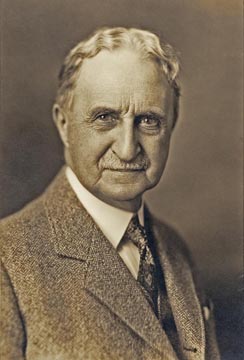
William Roedel Rathvon, CSB,, sometimes incorrectly referred to as William V. Rathvon or William V. Rathbone, is the only known eyewitness to Abraham Lincoln's Gettysburg Address, of the over 10,000 witnesses, to have left an audio recording describing that experience. He made the recording in 1938, a year before his death. A graduate of Franklin and Marshall College in Lancaster, Pennsylvania, and a successful businessman, he became a Christian Science practitioner, served as a public lecturer, Church treasurer and director of The First Church of Christ, Scientist in Boston, Massachusetts. He was treasurer from 1911 until he was elected to the Church's Board of Directors, on which he served from 1918 until his death in 1939. From 1908 to 1910 he was correspondence secretary for Christian Science founder Mary Baker Eddy. He also authored "The Devil's Auction" often republished without attribution as "The Devil's Garage Sale".

The Massachusetts Metaphysical College was founded in 1881 by Mary Baker Eddy in Boston, Massachusetts, to teach her school of theology that she named Christian Science. After teaching for almost seven years, Eddy closed this college in 1889 in order to devote herself to the revision of her book, Science and Health with Key to the Scriptures, but retained her charter and reopened the college in 1899 as an auxiliary to her Church.

The Mary Baker Eddy Library is a research library, museum, and repository for the papers of Mary Baker Eddy, the founder of Christian Science.
Mary Baker Eddy Home or Mary Baker Eddy House or similar may refer to:
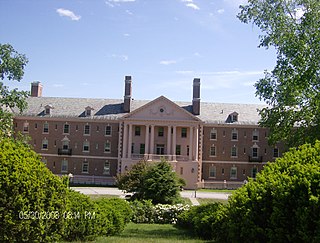
The Pleasant View Home is an historic senior citizen residential facility located at 227 Pleasant Street in Concord, New Hampshire, in the United States. On September 19, 1984, it was added to the National Register of Historic Places.
Mary Beecher Longyear was an American philanthropist and wife of John Munro Longyear, a wealthy businessman. She funded the first King James Version of the Bible in Braille and was a patron of the arts, education and benevolent organizations. A student of Christian Science, in 1911, she began collecting documents and items related to the early development of the religion and later established the Longyear Museum to further this work.

Rev. Irving Clinton Tomlinson was an American Universalist minister who converted to Christian Science, becoming a practitioner and teacher. For a time, he lived as one of the workers in the household of church founder, Mary Baker Eddy, later writing a book about his experiences called Twelve Years with Mary Baker Eddy.

Annie MacMillan Knott was a practitioner and teacher in The First Church of Christ, Scientist. She was a student of Mary Baker Eddy, the founder of the religion, and served the church in various capacities including First Reader, Associate Editor of the Christian Science periodicals, member of the Bible Lesson Committee, one of the first women on the Christian Science Board of Lectureship, Trustee under the Will of Mary Baker Eddy, and the first woman to become a member of the Christian Science Board of Directors.
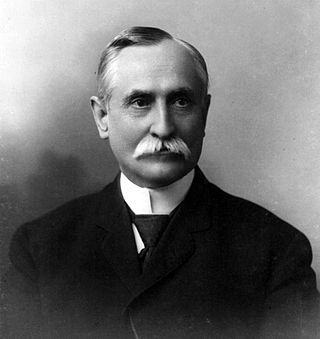
Calvin Augustine Frye was the personal assistant of Mary Baker Eddy (1821–1910), the founder of Christian Science.

The Reuben Foster House and Perley Cleaves House are a pair of nearly identical Greek Revival houses at 64 and 62 North State Street in Concord, New Hampshire. Built 1848–1850, they are among New Hampshire's best examples of Greek Revival architecture, having undergone only relatively modest alterations. The houses were listed on the National Register of Historic Places in 1982. The Cleaves House is further notable for its association with Mary Baker Eddy, and now serves as a historic house museum.
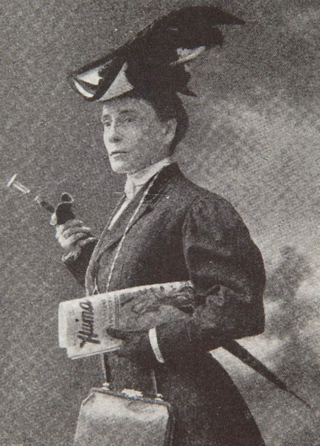
Sibyl Wilbur O'Brien Stone, best known as Sibyl Wilbur, was an American journalist, suffragist, and author of a biography of Mary Baker Eddy. She was a San Diego Branch Member of the National League of American Pen Women and a member of the New England Woman's Press Association.

The Mary Baker Eddy House is a historic house museum at 8 Broad Street in Lynn, Massachusetts. Built in 1870–71, it was the home of Mary Baker Eddy (1821-1910), founder of the Church of Christ, Scientist, from 1875 to 1882. The house is now owned by the church, which operates it as a historic site devoted to Eddy's life and early church history. The house was designated a National Historic Landmark in 2021, and was included in the Diamond Historic District in 1996.
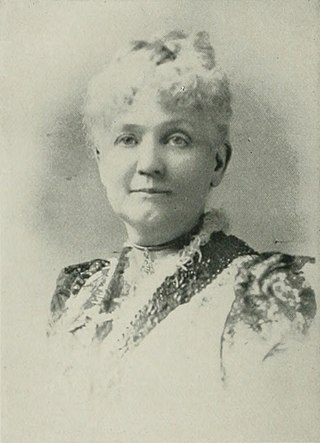
Sue Harper Mims, C.S.D., was a social leader in Atlanta, Georgia and the wife of Livingston Mims, the 37th mayor of Atlanta. She was a member of The First Church of Christ, Scientist, and helped found its branch church in Atlanta.


















